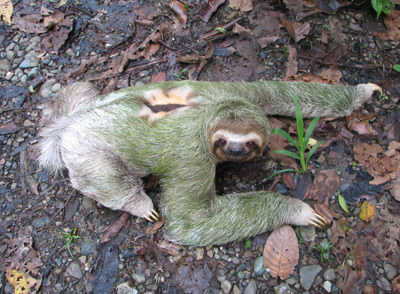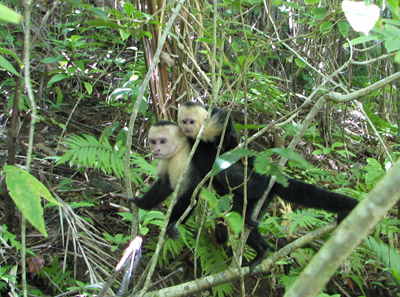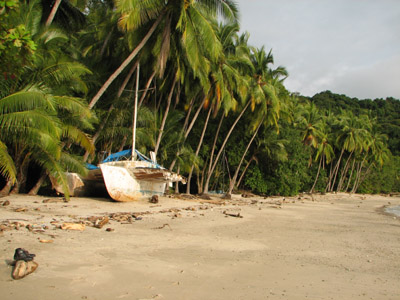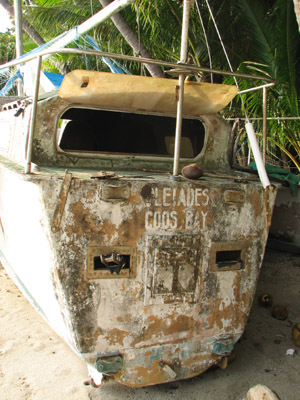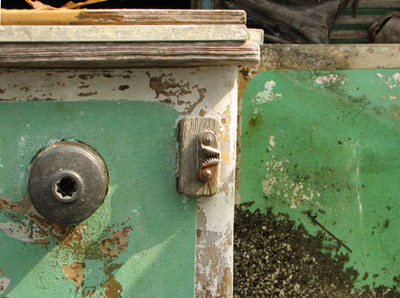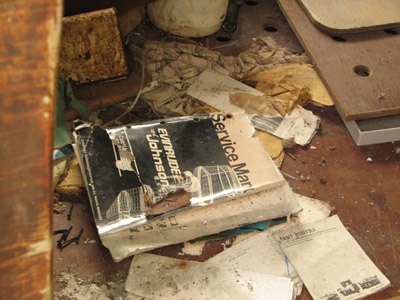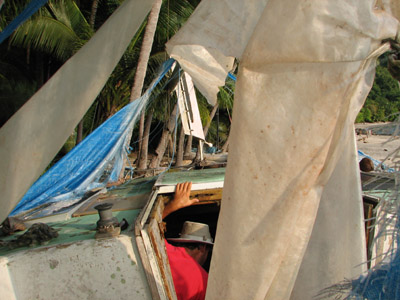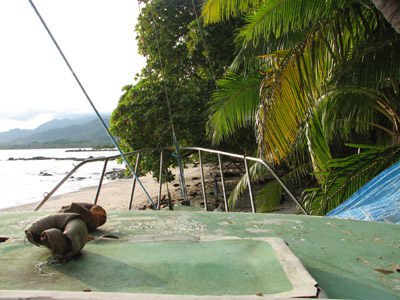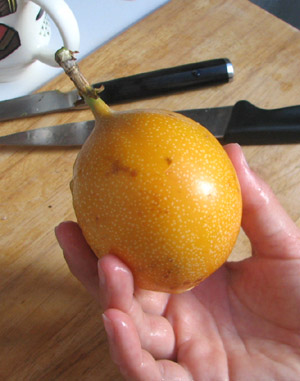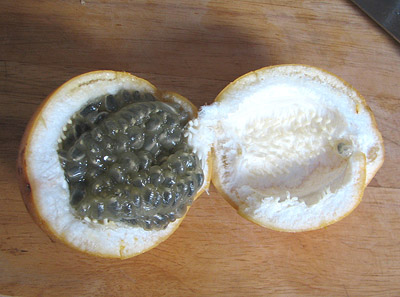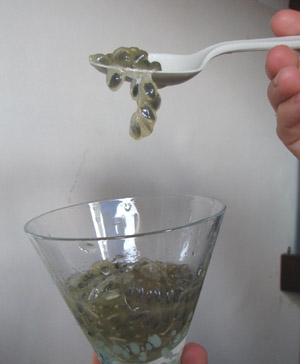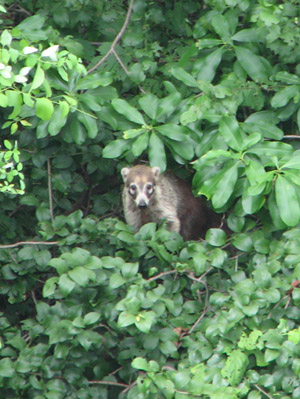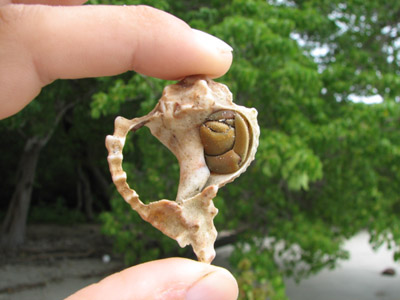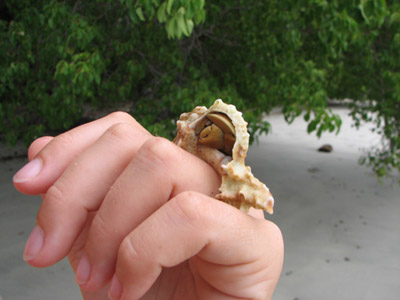Bahia Drake to Golfito
Wednesday, November 29th, 2006According to Charlie’s Charts, there is one anchorage between Parque Manuel Antonio and Bahia Drake; it breaks the trip up into two nice day-long sails. We set out for Bahia Uvita under light wind and arrived about an hour to sunset with a storm about to dump on us and our wind about to die. Our charts show Uvita as a hammer-shaped lump at the end of the spit of land, thereby creating a little protected nook to anchor; Charlie’s doesn’t show the hammer but it has a little island and says that the exposed reef cuts the swell to create a mellow spot to anchor. In actuality, a storm at some point must have wiped out all land lumps and islands because now there exists only a blunt nub of land with a mile-long exposed reef sticking off the end. The swell comes over this and breaks up into billions of choppy wavelets that create a high-frequency barrage of wakes, thereby turning the anchorage into a godawful mayhem. We discovered this around the time the wind died, the sun set, and the rain started; so we stayed.
It was a rolly, lurchy, violent night and neither of us got the Beauty Sleep; by four or so the next morning, we climbed out of bed and staggered around the boat getting coffee started and trying to get the motor started. Naturally, the motor refused to start and managed only a choking cough sound every time its cord was pulled. We gave up on it and just pulled up the anchor under sail. With maybe two or three knots of wind and the frightful chop generated off the reef, “sailing†out of the anchorage was a vexing experience. We physically held the sails out to keep them from flogging and to try to hang onto what little air there was. At four in the morning we did this. An hour later, we were only 1/2 mile from where we started but we were just far enough around the reef so that we were fully exposed to the open swell; here, thankfully, it was calm enough for Joshua to take the carburetor apart without fear of falling overboard. By hour two, we were still within a mile of the anchorage (lame!) but the wind began to pick up (sweet!). Joshua, who is a fucking genius, actually got the motor running after whatever it was he did to the carburetor and we ran it for a while to give ourselves the impression of forward progress and until we were well out of the reef area. Then we killed it to sail under wind power.
The sail to Bahia Drake actually turned out to be excellent after the rocky start; the wind picked up steadily until late afternoon when it peaked at around 15 knots (perfect wind for a beat) and we were flying through the relatively calm seas. We found a promising-looking scum line (yes, excitement abounds upon the Time Machine) and sailed along it for several miles while trailing delicious plastic squids through the water; sadly, the dorado shunned our lures and our dinner that night was not to consist of the Fish of Opportunity. (Actually, we did snag one skipjack but threw it back because that’s the only one I don’t like.) At sunset we entered Bahia Drake and anchored. The bay is lined with beautiful jungle hills, few scattered houses, no mega time-share high rises, reddish sand beaches, and several river estuaries. There were only a few fishing pangas and one other sailboat in the anchorage. The hills glowed amber and glass windows reflected gold in the setting sunlight.
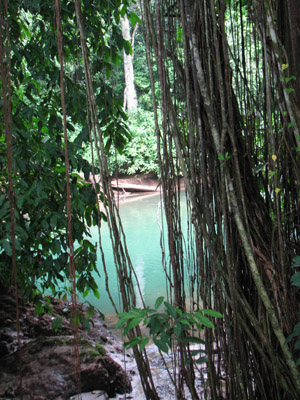
Bahia Drake turned out to be just as gorgeous by day as it seemed the night before. It is remote—the only way to get there often is by boat (yes, we rock) because the rainy-season creates some appalling jeep-swallowing ruts. It also is at the northern edge of the Corcovado National Park, which encompasses a large portion of the Osa peninsula and is one of the largest, most primeval, oldest, tallest, with the most abundant and unique flora and fauna, and a-few-other-things-else-est park in the entire world (if you believe everything you read). There is a small town with a medical compound complete with scrub-bedecked nurses prowling the local ‘sodas’ during the lunch hour and a few “eco-resorts,†which are schmancey hotels nestled amongst the jungle foliage rather than high-rising out of a cleared portion of it, with bars and restaurants and artful landscaping all around everything–and they also cost a bloody fortune. Eco-resorts are invariably owned and run by gringos. There is a trail running down the southern edge of the bay down the coast goes all the way around to Puerto Jimenez, but we followed it only until Bahia Pariaso, maybe six miles away. Along the way you keep feeling like you have left it all behind and I-hope-we-brought-enough-power-bars, but then another kilometer down, you stumble into a clearing where there is a tent camp and a running generator or something (you can hike all over the peninsula, tent camp to tent camp); this time of the year sees few tourists since it is still officially rainy season. We initially worried that we had set off on the hike without enough water but this turned out to be stupid because there were coconuts all over the place and those eco-tent-resort things every few kilometers. Periodically, we would collect a couple of coconuts and bash them open on the rocks (not easy) for the water inside, then continue down the trail munching on the nutmeat. (By the way, coconut husk juice splatters widely and stains badly.) (Oh, also, never eat too much fresh coconut meat because it, um, makes one’s intestinal tract slickery, if you catch my drift.)

The third day, we had planned a leisurely kayak up one of the rivers at high tide, but when lowering the kayak into the water, the Cordura casing ripped and so, until we fix it, that is the end of the kayak. The wind started blowing so we just put our stuff away and took off for Golfito, located around the tip of the Osa peninsula inside the gulf. Mom was due to arrive in a few days anyway so it probably was best we had a chance to scope out the scene and stock up on martini ingredients.
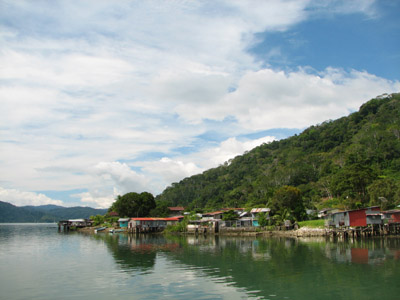
The run to Golfito was an overnight run for us; we wanted to give ourselves a lot of time in case the wind was light and we made poor time. Typically I prefer the second and fourth watches. I dislike the first watch because, although I am infrequently tired right at 6 or 7pm, I fear the initial onset of darkness when we are sailing along into the night with all those night preparations and putting away of things and all that. I like to just try to go to bed immediately and forget about it all. Waking up at midnight for a three-hour watch seems less freakish to me. Jeff always called this the ‘Dog Watch.’ You just get up and it is already dark and you are disoriented because you just were woken up after getting very little fitful sleep but you go above after donning what you assume must be the appropriate clothing and look around and assess the situation, take over the steering wheel and resume. If I am lucky, there aren’t any squalls, I don’t have to do any extensive sail readjusting, don’t have to start the motor (and wake up Joshua because our motor is being lame lately and I don’t have the explosive strength in my arms to pull-start the bastard), and don’t fall asleep. About half the time this is true and I get through the watch without checking the clock on the GPS too many times and then I get to go back to sleep. I know I am really tired when I have a hard time keeping our course straight. Once back in the bunk and a groggy Joshua deposited back into the cockpit, I dream all sorts of confused weirdness; then I get woken three or four minutes later by a very tired Joshua. In reality, three hours have again passed and by now it is the morning shift. Joshua summons the last of his strength to report every light that has passed and how well he could see it and how our course has changed a whole 15 degrees because actually this is the most exciting thing that has happened all night and then he goes below and passes out cold. And I am again sitting in the cockpit blinking my eyes and wondering if there might be any cookies left.
Dawn happens about sixty billion hours later and this particular dawn, on that very uneventful night around Matapalo towards Golfito, the sun rose over heavily cloudy and obscured skies; then it rained. Very hard. I saw it coming and buttoned up the boat tight; then I popped open the umbrella and stood in our cockpit beneath the downpour, listening to the roar. The wind had died utterly and the water was mashed flat by the force of the raindrops but I just stood and waited another hour until Joshua woke up to get the motor started for the last mile into Golfito bay.

